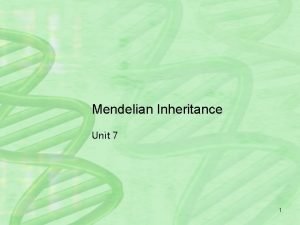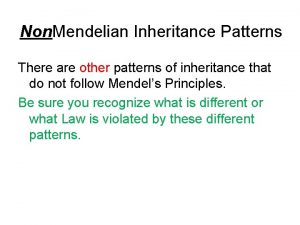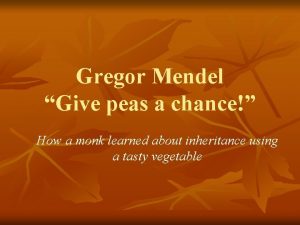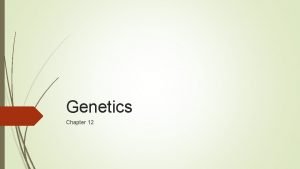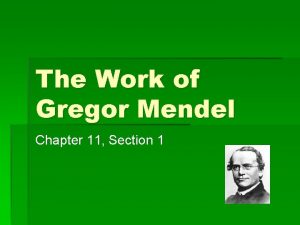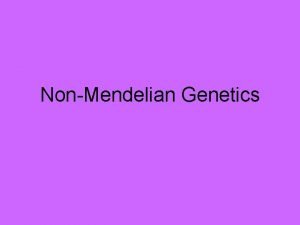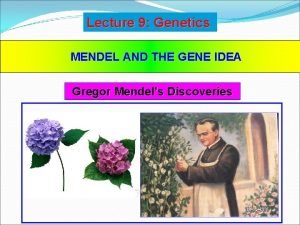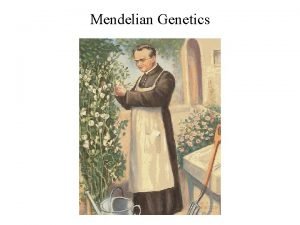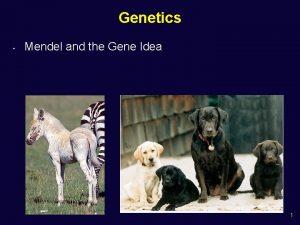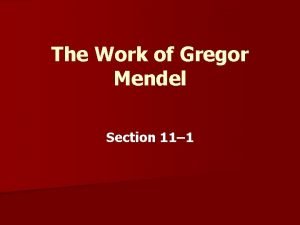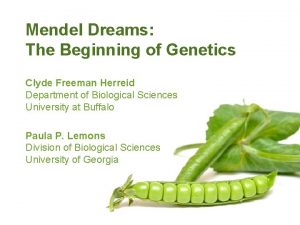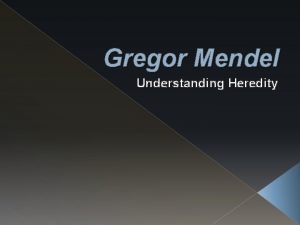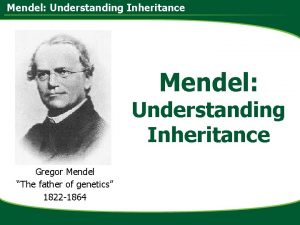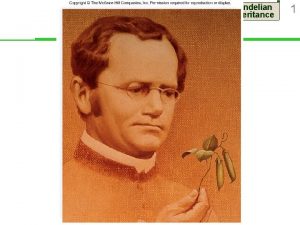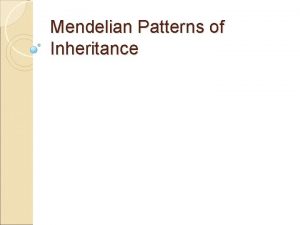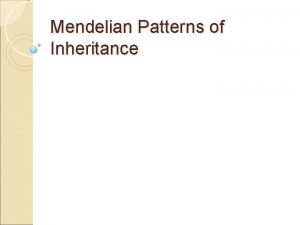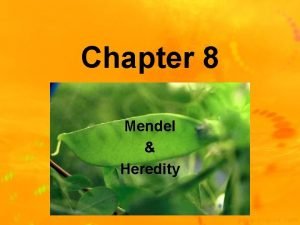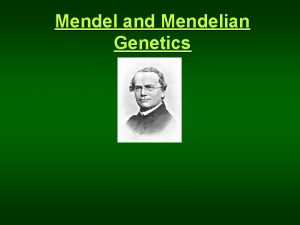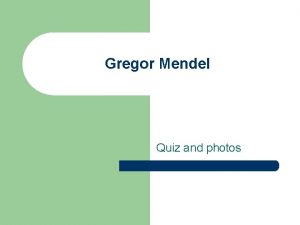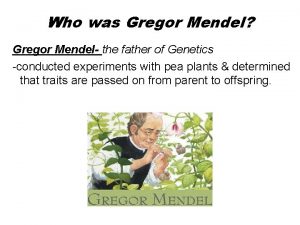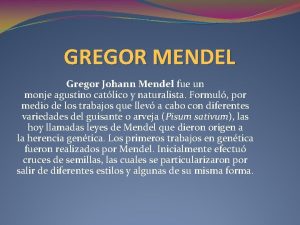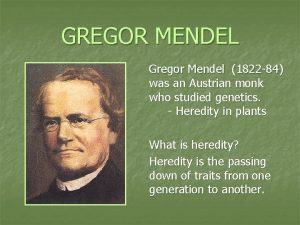Mendelian Patterns of Inheritance Chapter 9 Gregor Mendel

















- Slides: 17

Mendelian Patterns of Inheritance Chapter 9

Gregor Mendel v Monk who lived in early 1860’s. v Wanted to know heredity was passed on from generation to generation. v 1800’s theory: Blending Concept v Both parents contribute equally to offspring. v EX: red flower + white flower = pink

Mendel’s Experiment v Worked with PEA plants v Why: 1. Easy to cultivate 2. Has a short generation time 3. Easily cross pollinated 4. Many varieties

Pea Plant Traits

Mendel’s Final Theory v Particulate Theory of Inheritance: Inheritance is based on the existence of minute particles called genes; these genes are reshuffled from generation to generation.

One-Trait Inheritance v v Chose plants that differed only in ONE trait Parent Generation : P 1 st Generation : F 1 2 nd Generation : F 2

v Alleles: different forms of genes v Letters are assigned for different alleles (traits) v Y = yellow y = green v Dominant (Y) – visible trait v Recessive (y) – hidden trait v Homozygous – a trait where 2 alleles are the same (yy or YY) v Heterozygous – a trait where 2 alleles are different (Yy) v Genotype – the alleles the individual receives v Phenotype – the physical appearance


Punnett Square v Represents a cross between 2 parents, showing all possible offspring.

Practice Problem v In rabbits, if B = black hair, and b= white hair. When two heterozygous parents are crossed, B b what are the offsprings? -one trait cross- B BB Bb bb

Practice Problem v What is the phenotypic ratio? ? 3: 1 B b B BB Bb bb 3 = black 1 = white

Practice Problem v In pea plants, if Y = yellow, and y = green peas, and T = tall plant, and t = short plant. When two heterozygous parents are crossed, what are the offsprings? YT -two trait cross- YT YYTT Yt y. T yt YYTt Yy. TT Yy. Tt Yt YYTt YYtt Yy. Tt Yytt y. T Yy. Tt yy. TT yy. Tt yt Yy. Tt Yytt yy. Tt yytt

Practice Problem v What is the phenotypic ratio? ? 9: 3: 3: 1 9 = yellow & tall 3 = yellow & short 3 = green & tall 1 = green & short YT YT YYTT Yt y. T yt YYTt Yy. TT Yy. Tt Yt YYTt YYtt Yy. Tt Yytt y. T Yy. Tt yy. TT yy. Tt yt Yy. Tt Yytt yy. Tt yytt

DNA Structure Chapter 10

History v v Mendel knew that inheritance was passed on, but he didn’t know what! Two molecules that were thought to pass on inheritance – DIDN’T KNOW WHICH ONE 1. 2. Proteins DNA

DNA Structure v Watson and Crick – 1962 v Nucleotides bonded together in a double helix v 1. 2. 3. 4. 4 different ones A = adenine T = thymine G = guanine C = cytosine A=T G=C

Replication of DNA Eukaryote Prokaryote
 Difference between mendelian and non mendelian inheritance
Difference between mendelian and non mendelian inheritance Mendelian inheritance patterns
Mendelian inheritance patterns Chapter 12 lesson 1 the work of gregor mendel
Chapter 12 lesson 1 the work of gregor mendel Chapter 12 lesson 1 the work of gregor mendel
Chapter 12 lesson 1 the work of gregor mendel Chapter 11 the work of gregor mendel
Chapter 11 the work of gregor mendel Non mendelian inheritance
Non mendelian inheritance Cystic fibrosis mendelian inheritance
Cystic fibrosis mendelian inheritance Probability laws govern mendelian inheritance
Probability laws govern mendelian inheritance Mendel experiments in plant hybridization
Mendel experiments in plant hybridization Chromosomes and alleles
Chromosomes and alleles Mendel's experimental design
Mendel's experimental design Who is gregor mendel and what is he famous for
Who is gregor mendel and what is he famous for Why did mendel prevent his plants from self-pollinating?
Why did mendel prevent his plants from self-pollinating? Austrian genetic traits
Austrian genetic traits Gregor mendel father of genetics
Gregor mendel father of genetics Gregor mendel's dream was to?
Gregor mendel's dream was to? Gregor mendel chart
Gregor mendel chart Incomplete dominance
Incomplete dominance
